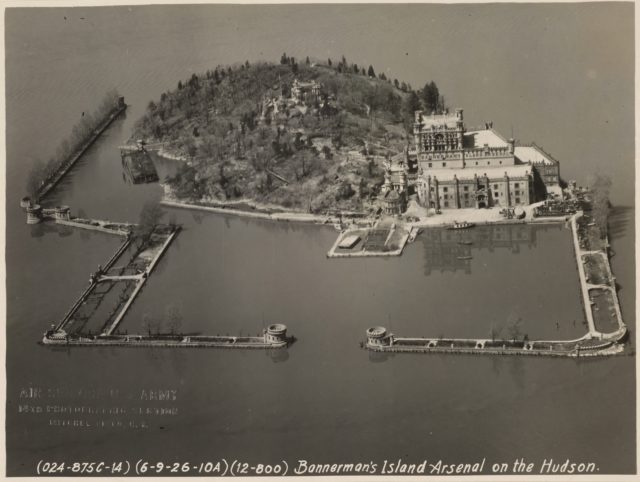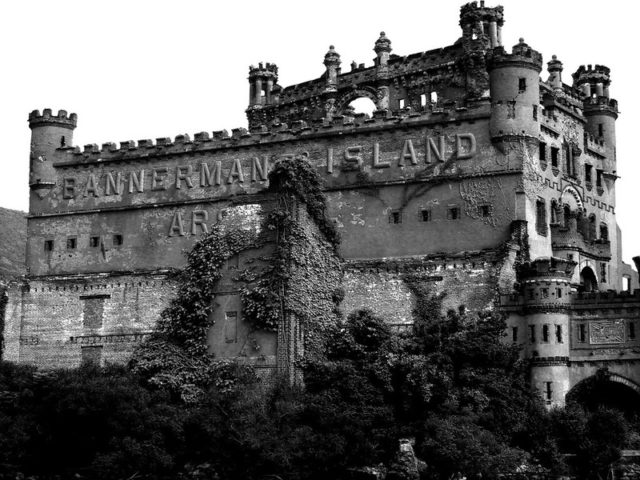The long and storied past of Bannerman Castle, tucked away on Pollepel Island in the Hudson Highlands of New York State, extends far beyond the abandoned fortress left in ruins. In fact, the island has long been considered haunted by the Indigenous peoples of the area. From Dutch settlement to the American Revolution to the downfall of its builder, the rubble of this once-great castle has many stories to tell.
Early history
Bannerman Castle is located in the middle of the Hudson River. Pollepel Island originally got its name from a local legend about a young girl named Polly Pell, who was rescued from the treacherous river ice in the winter and landed on the island’s shore. She fell in love with her rescuer and the pair were married on the island which now bears her name.

The legend likely came from Dutch sailors who frequented the island as a safe haven against potential attacks from local Indigenous peoples, who avoided the island that they believed was home to dark spirits.
In 1777, American revolutionaries tried to defend the Hudson Highlands using “chevaux de frise,” or Frisian horses – a system of sunken logs and wooden structures fitted with pointed rods that destroyed the hull of passing enemy ships. Unfortunately, the British quickly discovered the underwater defenses and began using flat-bottomed boats to avoid the defensive obstacles.

Since the 1700s, Pollepel Island has been owned by just five people, but the most renowned owner was Francis “Frank” Bannerman, who built the castle. Bannerman was born in Scotland in 1851 and immigrated to Brooklyn, New York with his family as a child. While his father sold goods at Navy auctions, young Frank collected and sold scrap metal from the local harbor.

Frank became so successful that he dropped out of school and started a business selling various collected goods. At the end of the Civil War, he purchased Army surplus at auctions to resell, eventually traveling around the world sourcing more suppliers. His business became known as “Bannerman’s,” founded in 1865. Eventually, Frank Bannerman had acquired so many military surplus supplies that New York City officials urged him to store his goods outside of the city.

One day, while canoeing down the Hudson River, Franks’ son David spotted a small island, which was owned by the Taft family. The Bannermans purchased Pollepel island in 1900 to use as storage for the piles of military goods and ammunition owned by the Bannerman surplus business. On the side of one of the castle walls, a sign still reads “Bannerman’s Island Arsenal.”

In 1901, Francis Bannerman began constructing a castle in the style of old Scottish fortresses from his homeland. Mass amounts of equipment and munitions were shipped to the island until they were sold, but even though Bannerman was a weapons dealer he considered himself to be anti-war – even writing in one of his catalogs that he hoped the piles of weapons housed within the Bannerman Castle would one day be known as “The Museum of Lost Arts.”
Apart from storage, Frank and his wife Helen Bannerman constructed a beautiful summer house on the island, where Mrs. Bannerman kept flourishing gardens and terraces – some of which can be seen today.
Disrepair and ruin
By 1918, Francis Bannerman was dead and the castle remained unfinished. Several years later, two tons of explosives were accidentally detonated, destroying a part of the historic building. While many locals believed that it was caused by the same dark spirits believed to inhabit the island, officials reported that the explosion happened when lightning struck one of the castle’s flag poles. The explosion was the first of many tragedies to come.

In 1950, a cargo ship was caught in a huge storm on the Hudson River and crashed onto the island, exploding upon impact. As the second explosion the castle had seen, even more damage was done. Not long after the crash, the Bannerman business – like the castle – fell into disrepair as new government rules surrounding army surplus sales threatened the once great retailer. A final blow came when the local ferry that connected Bannerman Island to the mainland sank, making the island uninhabitable.

In 1969, a fire broke out and destroyed what remained of the building’s ceilings and floors. Now only the walls remain. Ongoing neglect over time has also caused large portions of the castle’s walls to collapse. Today, the Bannerman Castle Trust, a non-profit organization started by the wife of Francis Bannerman’s grandson, hosts tours of the abandoned castle to help keep its rich history alive.

As Francis Bannerman’s grandson Charles wrote in 1962: “No one can tell what associations and incidents will involve the island in the future. Time, the elements, and maybe even the goblins of the island will take their toll on some of the turrets and towers, and perhaps eventually the castle itself, but the little island will always have its place in history and in legend and will be forever a jewel in its Hudson Highland setting.”
More from us: The Renwick Ruin: Roosevelt Island’s Abandoned Smallpox Hospital
It is likely that the historic castle will never be restored. Instead, it has been left to slowly decay over time – where it will be returned to the spirits who call the island home.
